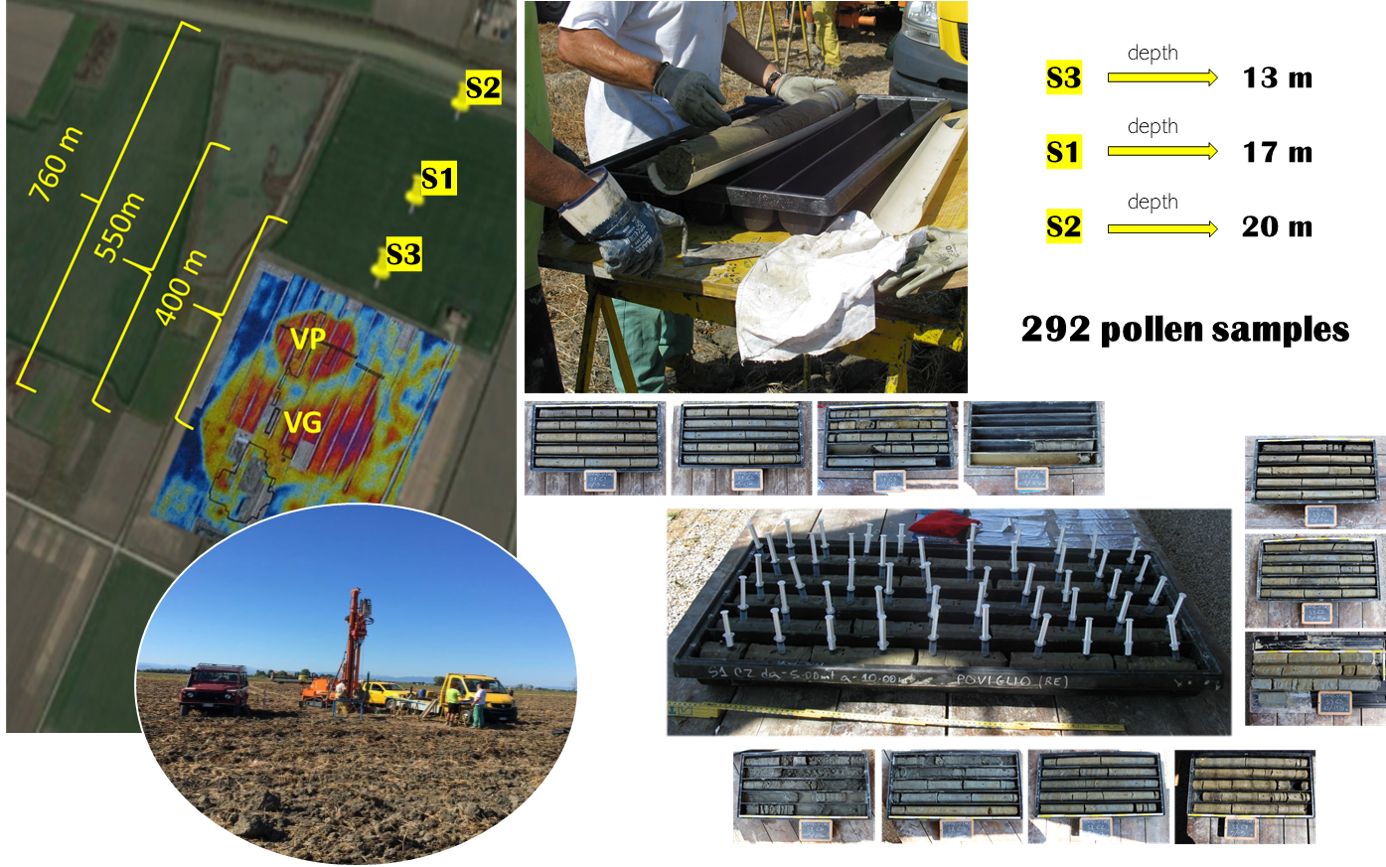Climate change and human impact in a long-term perspective: palynology of Middle-Late Holocene deposits in the Po Plain
PhD Thesis (2018-2021) by Eleonora Clò, PhD Course in "Models and Methods for Material and Environmental Sciences" (http://www.m3es.unimore.it/site/home.html)
Tutor: Prof.ssa Anna Maria Mercuri, Laboratorio di Palinologia e Paleobotanica, Dipartimento di Scienze della Vita, Università di
Modena e Reggio Emilia
Co-Tutor: Prof. Mauro Cremaschi, Dipartimento di Scienze della Terra “A. Desio”, Università Statale di Milano
English version
Palynological data (pollen and spores) are used in multidisciplinary studies for a wide number of applications as, for example, palaeoecology, palaeoclimatology and archaeology. The response of wild vegetation or landscapes to climatic and environmental changes, as well as to human impacts, can be studied through detailed pollen analysis. From the results obtained, these types of researches are living a period of great growth of the study pathways and methodologies. The aim of the thesis project is to investigate the stress caused by climate changes to the environment and natural resources and identify the adaptive responses of human societies formulating sustainable models in the exploitation of resources. The time range selected is the cultural period of the Terramara society in the alluvial plain of the Po River (Emilia Romagna region) during the Middle/Recent Bronze Age.Starting from the on-site analysis already carried out (showing evidence of local human activities), it is now necessary to implement off-site palaeoenvironmental reconstruction studies to build an important reference for the lasting changes on a regional scale.The study is focused on three off-site cores collected at different distances from the archaeological site “Terramara Santa Rosa di Poviglio” (1550 – 1170 BC) in the summer 2018. The information that will be obtained from pollen from each core will be added to stratigraphical descriptions, radiocarbon datings and organic substance analyses, in addition to the archaeological analyses. The strong interdisciplinary perspective and the integration with on-site studies facilitate the investigation of the climatic and anthropic contributions to environmental changes in the region, and their relationships with the different adaptive behavior of the Terramare people.Santa Rosa di Poviglio is an archaeological site that has been investigated since more than 30 years under the direction of Mauro Cremaschi (Università Statale di Milano) and Maria Bernabò Brea (Soprintendenza Archeologia dell'Emilia-Romagna) and now is included into the 3-year research Project SUCCESSO-TERRA (http://www.palinopaleobot.unimore.it/site/home/research/laboratory-project/2016-2019-successo-terra-project.html) funded by Ministry of Education, University and Research (PRIN-20158KBLNB) - an interdisciplinary geoarchaeological and palynological investigation. The project aims to understand the relationship between humans, climate and the environment over the last millennia: from the onset of the Terramara culture to the following phases.
Versione italiana
I dati palinologici (polline e spore) sono utilizzati in studi multidisciplinari con un ampio numero di applicazioni, ad esempio paleoecologia, paleoclimatologia e archeologia. La risposta della vegetazione naturale e del paesaggio ai cambiamenti climatici e ambientali, nonché all'impatto umano, può essere studiata attraverso un'analisi dettagliata del polline. Grazie ai risultati ottenuti, le metodologie di studio di queste ricerche stanno vivendo un periodo di grande crescita. Lo scopo di questa tesi di dottorato è investigare lo stress causato dai cambiamenti climatici sull'ambiente e sulle risorse naturali e identificare le risposte adattative delle società umane formulando modelli sostenibili di sfruttamento delle risorse. L'intervallo di tempo selezionato è il periodo culturale della società terramaricola, presente nella pianura alluvionale del fiume Po (regione Emilia-Romagna) durante l'Età del Bronzo Medio / Recente. Partendo dall'analisi già effettuata all’interno del sito archeologico (che mostra evidenze delle attività umane locali), è ora necessario implementare gli studi di ricostruzione paleoambientale fuori sito per ottenere un importante riferimento sui cambiamenti a lunga scala temporale a livello regionale. Lo studio è incentrato su tre carotaggi eseguiti a diverse distanze dal sito archeologico Santa Rosa di Poviglio (1550 – 1170 a.C.) nell'estate 2018. Le informazioni che saranno ottenute dalle analisi polliniche eseguite per ogni carotaggio saranno integrate con descrizioni stratigrafiche, datazioni al radiocarbonio e analisi di sostanza organica, oltre le analisi archeologiche. La forte prospettiva interdisciplinare e l'integrazione con gli studi eseguiti all’interno del sito consentono di indagare il contributo climatico e antropico ai cambiamenti ambientali su scala regionale e le loro relazioni con i diversi comportamenti adattivi delle popolazioni terramaricole. Santa Rosa di Poviglio è un sito archeologico indagato da oltre 30 anni sotto la direzione di Mauro Cremaschi (Università Statale di Milano) e Maria Bernabò Brea (Soprintendenza Archeologia dell'Emilia-Romagna) ed è incluso nel progetto di ricerca SUCCESSO-TERRA, di durata triennale, finanziato dal Ministero dell'Istruzione, dell'Università e della Ricerca (PRIN-20158KBLNB) - un'indagine interdisciplinare geoarcheologica e palinologica. Il progetto mira a comprendere la relazione tra uomo, clima e ambiente negli ultimi millenni: dall'inizio della civiltà terramaricola alle fasi successive.


